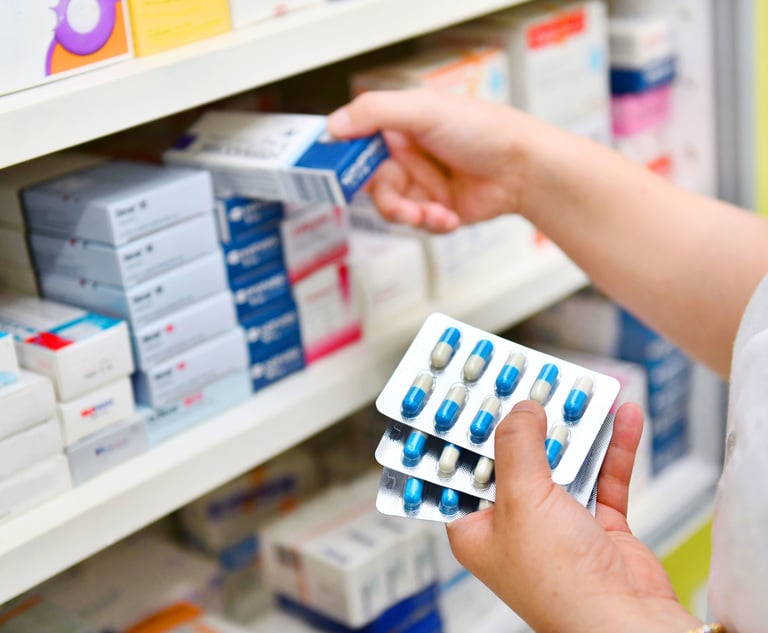 Credit: vchalup/Adobe Stock
Credit: vchalup/Adobe Stock Pharmaceutical Due Diligence Practice Tips for New Drugs
The primary goal of a patent practitioner performing due diligence of a new drug should be to identify all risks associated with commercialization of the drug product and to determine the potential for market exclusivity.
September 29, 2022 at 10:00 AM
8 minute read
The Food and Drug Administration (FDA) has approved on average 38 new drugs per year from 2010 through 2019, with a peak amount of 59 drugs approved in 2018. Congressional Budget Office, Research and Development in the Pharmaceutical Industry (April 2021). By the time a new drug is available to consumers, an extensive development process has taken place. This process, from drug candidate to FDA-approved drug and subsequent market release, is both time-consuming and expensive. It often takes a decade or more and has been estimated to cost more than $1 billion dollars. Id. Within this decade, it is important to perform due diligence on the drug and its related processes of making and using it. The same is true when contemplating an acquisition during this time period, whereby the drug and its development transfers to a new owner. Transfer of ownership of the drug is a common occurrence. In fact, about one-fifth of drugs in the development process have been acquired by another pharmaceutical company for commercialization. Id.
There are two important due diligence items to examine before bringing a new drug to market or acquiring it prior to market launch. The first item is a freedom to operate (FTO) assessment to determine whether the commercialization of the drug would infringe any third-party patents. The second item is identifying any market exclusivity that the drug is expected to receive after obtaining FDA approval.
This content has been archived. It is available through our partners, LexisNexis® and Bloomberg Law.
To view this content, please continue to their sites.
Not a Lexis Subscriber?
Subscribe Now
Not a Bloomberg Law Subscriber?
Subscribe Now
NOT FOR REPRINT
© 2025 ALM Global, LLC, All Rights Reserved. Request academic re-use from www.copyright.com. All other uses, submit a request to [email protected]. For more information visit Asset & Logo Licensing.
You Might Like
View All
First-of-Its-Kind Parkinson’s Patch at Center of Fight Over FDA Approval of Generic Version
3 minute read
Intellectual Property Lawyer of the Year Finalist: Ronald S. Bienstock
1 minute read
McCarter & English Acquires Connecticut IP Boutique Harrington & Smith
Law Firms Mentioned
Trending Stories
- 1Corporate Litigator Joins BakerHostetler From Fish & Richardson
- 2E-Discovery Provider Casepoint Merges With Government Software Company OPEXUS
- 3How I Made Partner: 'Focus on Being the Best Advocate for Clients,' Says Lauren Reichardt of Cooley
- 4People in the News—Jan. 27, 2025—Barley Snyder
- 5UK Firm Womble Bond to Roll Out AI Tool Across Whole Firm
Who Got The Work
J. Brugh Lower of Gibbons has entered an appearance for industrial equipment supplier Devco Corporation in a pending trademark infringement lawsuit. The suit, accusing the defendant of selling knock-off Graco products, was filed Dec. 18 in New Jersey District Court by Rivkin Radler on behalf of Graco Inc. and Graco Minnesota. The case, assigned to U.S. District Judge Zahid N. Quraishi, is 3:24-cv-11294, Graco Inc. et al v. Devco Corporation.
Who Got The Work
Rebecca Maller-Stein and Kent A. Yalowitz of Arnold & Porter Kaye Scholer have entered their appearances for Hanaco Venture Capital and its executives, Lior Prosor and David Frankel, in a pending securities lawsuit. The action, filed on Dec. 24 in New York Southern District Court by Zell, Aron & Co. on behalf of Goldeneye Advisors, accuses the defendants of negligently and fraudulently managing the plaintiff's $1 million investment. The case, assigned to U.S. District Judge Vernon S. Broderick, is 1:24-cv-09918, Goldeneye Advisors, LLC v. Hanaco Venture Capital, Ltd. et al.
Who Got The Work
Attorneys from A&O Shearman has stepped in as defense counsel for Toronto-Dominion Bank and other defendants in a pending securities class action. The suit, filed Dec. 11 in New York Southern District Court by Bleichmar Fonti & Auld, accuses the defendants of concealing the bank's 'pervasive' deficiencies in regards to its compliance with the Bank Secrecy Act and the quality of its anti-money laundering controls. The case, assigned to U.S. District Judge Arun Subramanian, is 1:24-cv-09445, Gonzalez v. The Toronto-Dominion Bank et al.
Who Got The Work
Crown Castle International, a Pennsylvania company providing shared communications infrastructure, has turned to Luke D. Wolf of Gordon Rees Scully Mansukhani to fend off a pending breach-of-contract lawsuit. The court action, filed Nov. 25 in Michigan Eastern District Court by Hooper Hathaway PC on behalf of The Town Residences LLC, accuses Crown Castle of failing to transfer approximately $30,000 in utility payments from T-Mobile in breach of a roof-top lease and assignment agreement. The case, assigned to U.S. District Judge Susan K. Declercq, is 2:24-cv-13131, The Town Residences LLC v. T-Mobile US, Inc. et al.
Who Got The Work
Wilfred P. Coronato and Daniel M. Schwartz of McCarter & English have stepped in as defense counsel to Electrolux Home Products Inc. in a pending product liability lawsuit. The court action, filed Nov. 26 in New York Eastern District Court by Poulos Lopiccolo PC and Nagel Rice LLP on behalf of David Stern, alleges that the defendant's refrigerators’ drawers and shelving repeatedly break and fall apart within months after purchase. The case, assigned to U.S. District Judge Joan M. Azrack, is 2:24-cv-08204, Stern v. Electrolux Home Products, Inc.
Featured Firms
Law Offices of Gary Martin Hays & Associates, P.C.
(470) 294-1674
Law Offices of Mark E. Salomone
(857) 444-6468
Smith & Hassler
(713) 739-1250







